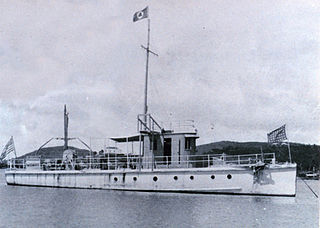
Walter Wyman was an American physician and soldier. He was appointed the third Surgeon General of the United States from 1891 until his death in 1911.

USS Flamingo (AM-32) was a Lapwing-class minesweeper built for the United States Navy near the end of World War I. After service overseas clearing mines after the Armistice, the ship was laid up until 1922 when she was transferred to the United States Department of Commerce for use by the United States Coast and Geodetic Survey. Renamed USC&GS Guide, the ship operated as a survey vessel along the West Coast of the United States for 17 years, making significant contributions to navigation, hydrographic surveying, and oceanography. In June 1941, Guide was transferred back to the Navy, converted into a salvage ship, and renamed USS Viking (ARS-1). As Viking, she worked primarily from bases in California until 1953, when she was sold for scrapping.

USS Oceanographer (AGS-3) was a survey ship of the United States Navy during World War II that produced charts chiefly of passages in the Solomon Islands area of the Pacific Ocean. Upon transfer to the Navy, she had initially briefly been named and classed as gunboat USS Natchez (PG-85). Before her World War II Navy service, she had been USC&GS Oceanographer (OSS-26), a survey ship with the United States Coast and Geodetic Survey from 1930.

The United States Coast and Geodetic Survey was the first scientific agency of the United States Government. It existed from 1807 to 1970, and throughout its history was responsible for mapping and charting the coast of the United States, and later the coasts of U.S. territories. In 1871, it gained the additional responsibility of surveying the interior of the United States and geodesy became a more important part of its work, leading to it being renamed the U.S. Coast and Geodetic Survey in 1878.

USS Lydonia (SP-700) was United States Navy patrol vessel in commission from 1917 to 1919 that saw service during World War I. Prior to her U.S. Navy service, she had been William A. Lydon's private yacht, Lydonia II, from 1912 to 1917. She spent most of the war based at Gibraltar, escorting and protecting Allied ships in the Mediterranean and along the Atlantic Ocean coast of Europe. After her U.S. Navy service ended, she served from 1919 to 1947 in the United States Coast and Geodetic Survey as the coastal survey ship USCGS Lydonia (CS-302).

USS Mobjack (AVP-27/AGP-7) was a motor torpedo boat tender in commission in the United States Navy from 1943 to 1946. She saw service in the Pacific theater during the latter portion of World War II.

USS Surveyor was an armed steamer that served in the United States Navy from 1917 to 1919. Prior to her U.S. Navy service, she operated as the survey ship USC&GS Surveyor for the United States Coast and Geodetic Survey in 1917, and she returned to that role after her U.S. Navy decommissioning, remaining in Coast and Geodetic Survey service until 1956.

NOAA Ship Surveyor was an oceanographic survey ship in commission in the National Oceanic and Atmospheric Administration (NOAA) from 1970 until 1995. Prior to her NOAA career, she was in commission in the United States Coast and Geodetic Survey from 1960 to 1970 as USC&GS Surveyor. She was the second and last Coast and Geodetic Survey ship named Surveyor and has been the only NOAA ship thus far to bear the name.
USS Olympic (SP-260) was a United States Navy patrol vessel in commission from 1917 to 1919. After her U.S. Navy career ended, she served in the United States Public Health Service as the boarding vessel USPHS Bailhache from 1919 to 1934. She then operated as the yacht, cargo vessel, and passenger vessel Moby Dick until 1989, except for a period of World War II United States Army service as USAS Q-108 from 1941 to 1946.

USC&GS Ranger was a steamer that served in the United States Coast and Geodetic Survey from 1919 to 1930 or 1931.

USC&GS Isis was a survey ship that served in the United States Coast and Geodetic Survey from 1915 to 1917 and from 1919 to 1920.

USC&GS Marindin was a launch that served as a survey ship in the United States Coast and Geodetic Survey from 1919 to 1944. She was the only Coast and Geodetic Survey ship to bear the name.

USC&GS Patton (ASV-80) was a survey ship that served in the United States Coast and Geodetic Survey from 1941 to 1967.

NOAAS Davidson was a survey ship in commission in the National Oceanic and Atmospheric Administration (NOAA) from 1970 to 1989. Prior to her NOAA service, she was in commission in the United States Coast and Geodetic Survey from 1967 to 1970 as USC&GS Davidson, the second Coast and Geodetic Survey ship of the name. She was the only sister ship of NOAAS McArthur.

The first USC&GS Explorer was a steamer that served as a survey ship in the United States Coast and Geodetic Survey from 1904 to 1939 except for a brief time in United States Navy service from 1918 to 1919 for patrol duty in Alaskan waters as USS Explorer during World War I. After initial service along the United States East Coast and off Puerto Rico, the ship transferred to Seattle, Washington in 1907 to begin survey work in Alaskan waters during summer and more southern waters along the United States West Coast in winter. On her return from the Navy in 1919, the ship was condemned and due to be sold but instead was retained as a survey vessel into the fall of 1939. After a stint with the National Youth Administration from 1939 to 1941, she saw service during World War II with the United States Army Corps of Engineers as the freight and supply ship Atkins.

NOAAS Ferrel was an American hydrographic survey ship that was in commission in the National Oceanic and Atmospheric Administration (NOAA) from 1970 to 2002. Prior to her NOAA career, she was in commission in the United States Coast and Geodetic Survey from 1968 to 1970 as USC&GS Ferrel.
USC&GS Derickson was a PCS-1376-class patrol craft sweeper/survey ship in service with the United States Coast and Geodetic Survey. Entering service in 1944, she was out of service by 1948, and sold by 1954.
Harry A. Marmer was a Russian Empire-born American engineer, mathematician and oceanographer who was a career employee of the United States Coast and Geodetic Survey. He was an internationally recognized expert on tides and currents.

USS Helianthus (SP-585) was a patrol vessel in commission in the United States Navy from 1917 to 1919, seeing service in World War I. After her U.S. Navy service, she was in commission in the United States Coast and Geodetic Survey as the survey launch USC&GS Helianthus from 1919 to 1939. She was named after the Helianthus, the genus to which the sunflower belongs.

USS Scandinavia (SP-3363) was a patrol vessel in commission in the United States Navy from 1918 to 1919, seeing service in World War I. After her U.S. Navy service, she was in commission in the United States Coast and Geodetic Survey as the survey launch USC&GS Scandinavia from 1919.

















